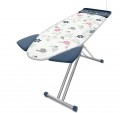The material from which the main working surface of the board is made.
—
Wood. Ironing boards can be crafted from various wood types: natural wood, chipboard, or plywood. While natural wood offers greater durability, it can make boards heavy. Chipboard and plywood allow for lighter constructions, but they are less durable, prone to deformation from moisture and high temperature. This issue is also present, to a lesser extent, with natural wood. Consequently, wood is primarily utilized in low-cost-friendly models.
—
Metal. Metal countertops typically feature a solid sheet with perforations for steam release, ensuring robustness due to the moisture-resistant alloys that resist deformation from iron's operating temperatures. However, these boards tend to be costly, and the longevity of the cover relies heavily on the quantity of holes—if too few, wear occurs more rapidly.
—
Metal mesh. A "lighter" alternative to solid metal countertops is the grid design. While slightly less durable than solid sheets, grids still offer reliability and resistance to deformation. Moreover, they provide better steam passage and are lighter in weight.
—
Thermoplastic. A special type of plastic, originally created as a material for ironing boards. With a small weight, it is resistant to heat and moisture, as well as goo
...d strength and reliability. The main disadvantage of this material is its high cost.—
Stand for iron. The presence in the design of a separate platform for placing an iron. Usually such a platform is made of heat-resistant materials (most often metal), which makes it possible to put a heated iron on it directly with the sole down. It's safer than placing it vertically on your work surface, and in most cases, it's also more convenient.
—
Height adjustment. The ability to change the height at which the work surface is placed. This feature is almost a must for modern ironing boards. for people of different heights and the optimal height of the board will be different (and even for one person in different situations it may be necessary to rearrange the work surface higher or lower).
—
Sleeve board. Availability in a set of delivery of a board of the adaptation for an ironing of sleeves. The undersleeve is usually a small, narrow and long area of the same material and with the same finish as the main work surface. It can either be fixed on the board or be a completely independent device with the ability to install on any flat surface.
—
Linen shelf. The presence in the design of the board of its own shelf for placing linen. Thanks to it, you do not have to unload each ironed item from the board separately: you can put several items in a pile on a shelf, and then move the entire pile to a place
...of permanent storage (for example, in a closet).
— Holder for hangers. The presence in the design of the ironing board of special devices for placing coat hangers. Mostly it is a removable metal arc, with recesses for attaching hangers.
— Built-in socket. Some models come with a built-in outlet for connecting the iron, essentially acting as an extension cord. This design allows for more flexibility in placement, especially in tight spaces where positioning the board near a wall outlet might not be feasible.
— Wire holder. The iron typically comes with a wire holder—a vertical metal "antenna" around 30 cm tall, with a spiral at the end serving as the actual holder. This design enhances convenience and safety by preventing wire tangling under hands and minimizing the risk of the cord getting under the hot soleplate and damaging insulation.
— Steam absorption function. This feature eliminates excess steam produced during steam ironing or while working on damp fabrics, ensuring that the ironed items remain as dry as possible. To manage the expelled steam, these boards typically include a ventilation function.
— Ventilation function. This function is performed by a system enabling air circulation within the board's working surface. This system offers two modes: the first gently "inflates" the cover, ideal for delicate fabrics, while the second, the blowing mode, is primarily employed to eliminate excess steam in boards with the respective function mentioned earlier.
— Heating of an ironing surface. The ironing board incorporates a heating system within its work surface to enhance heat provision. This allows simultaneous ironing on both sides, expediting the process and intensifying heat, particularly beneficial for drying damp laundry or ironing thick items that would otherwise require flipping to treat both sides.
— Foot control. A floor pedal that controls a specific function of the board, such as ventilation or heating of the work surface. Such control is convenient in that it does not require the use of hands — thus, you can turn on and off the corresponding function of the board without letting go of the iron and not being distracted from ironing.
— Transport rollers. As the ironing board is frequently moved from the workspace to storage, having wheels simplifies this process. Considering that the iron is typically used by individuals, particularly women, the addition of wheels enhances convenience when handling the board.
